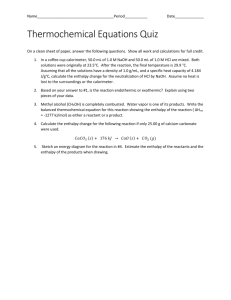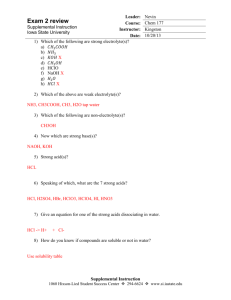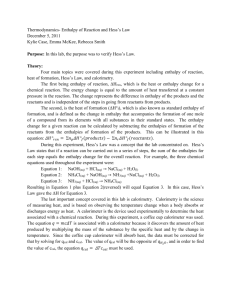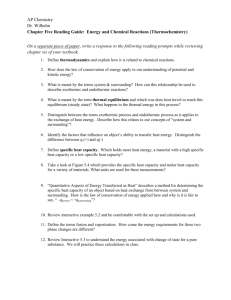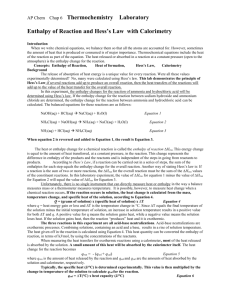Lab on Thermochemistry & Hess's Law
advertisement
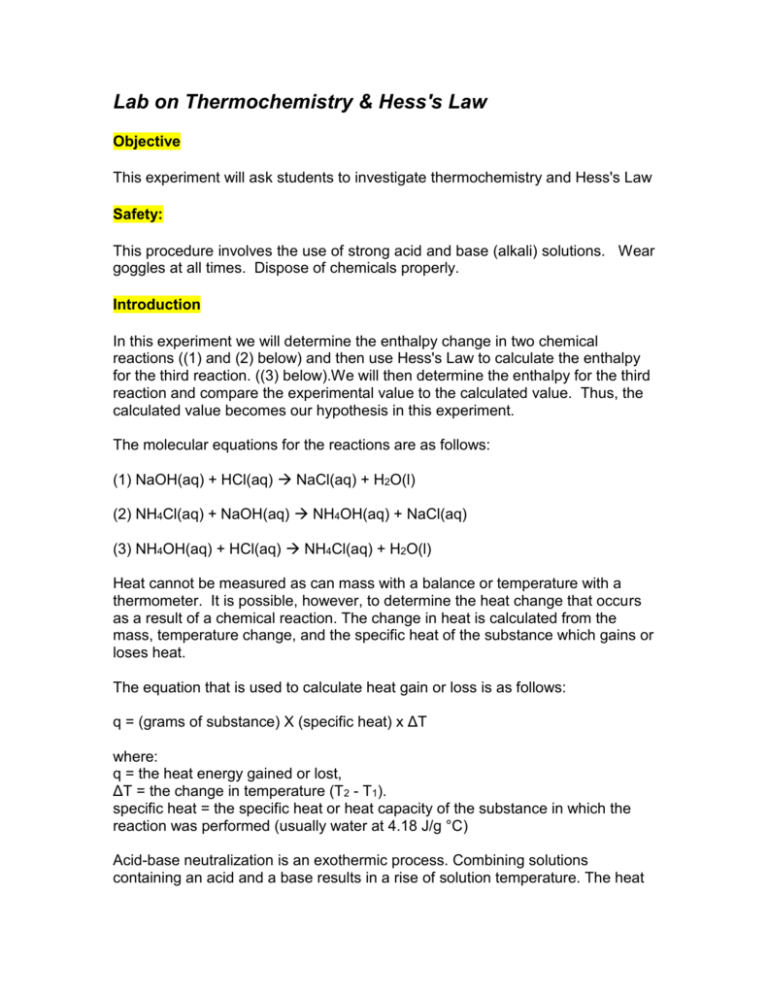
Lab on Thermochemistry & Hess's Law Objective This experiment will ask students to investigate thermochemistry and Hess's Law Safety: This procedure involves the use of strong acid and base (alkali) solutions. Wear goggles at all times. Dispose of chemicals properly. Introduction In this experiment we will determine the enthalpy change in two chemical reactions ((1) and (2) below) and then use Hess's Law to calculate the enthalpy for the third reaction. ((3) below).We will then determine the enthalpy for the third reaction and compare the experimental value to the calculated value. Thus, the calculated value becomes our hypothesis in this experiment. The molecular equations for the reactions are as follows: (1) NaOH(aq) + HCl(aq) NaCl(aq) + H2O(l) (2) NH4Cl(aq) + NaOH(aq) NH4OH(aq) + NaCl(aq) (3) NH4OH(aq) + HCl(aq) NH4Cl(aq) + H2O(l) Heat cannot be measured as can mass with a balance or temperature with a thermometer. It is possible, however, to determine the heat change that occurs as a result of a chemical reaction. The change in heat is calculated from the mass, temperature change, and the specific heat of the substance which gains or loses heat. The equation that is used to calculate heat gain or loss is as follows: q = (grams of substance) X (specific heat) x ΔT where: q = the heat energy gained or lost, ΔT = the change in temperature (T2 - T1). specific heat = the specific heat or heat capacity of the substance in which the reaction was performed (usually water at 4.18 J/g °C) Acid-base neutralization is an exothermic process. Combining solutions containing an acid and a base results in a rise of solution temperature. The heat given off by the reaction (which will cause the solution temperature to rise) can be calculated from the specific heat of the solution, the mass of solution and the temperature change. This heat quantity can then be converted to the enthalpy change for the reaction in terms of kJ/mole by using the concentrations of the reactants. According to Hess's Law, if a reaction can be carried out in a series of steps, the sum of the enthalpies for each step should equal the enthalpy change for the entire reaction. Another way of stating "Hess's Law" is: If two chemical equations can algebraically be combined to give a third equation, the values of ΔH for the two equations can be combined in the same manner to give ΔH for the third equation. We can see in the acid -base equations shown above that if equation (2) is subtracted from equation (1), equation (3) will result. Therefore, if the value of ΔH for equation (2) is subtracted from that of equation (1), the enthalpy change for equation (3) should result. Materials Hydrochloric acid, 3.0 M Ammonium chloride, 3.0 M Sodium hydroxide, 3.0 M Ammonium hydroxide, 3.0 M Calorimeter made from two nested styro-foam cups thermometer (0 to 110°C) 25-mL graduated cylinder Procedure 1. Set up calorimeter (two nested styrofoam cups) with thermometer. 2. Obtain 25.0 mL of 3.0 M HCl and add to calorimeter. Determine temperature to nearest 0.2°C. 3. Rinse graduated cylinder and obtain 25.0 mL of 0.3 M NaOH. Determine temperature to nearest 0.2°C. If the temperature for the two solution does not agree, then average the two temperature and use that as your initial temperature. 4. Add the 3.0 M NaOH to the 3.0 M HCl in the calorimeter. Stir the solution with the thermometer and record the temperature to nearest 0.2°C every 20 seconds for 3.0 min. 5. Repeat the above process with the reactants in equations (2) and (3). Be sure that the containers are rinsed between each set of reactions. Discard the solutions in the sink. Calculations: 1. For each of the three reactions prepare a graph of temperature versus time (x-axis). Extrapolate back to to zero time to find the instantaneous temperature of mixing 2. Calculate the heat of the reaction for each of the three reactions using the following equation: Heat = Sp. Heat H2O x density of solution (1.05g/mL) x volume x ΔT 3. Use Hess's Law to predict the enthalpy for reaction (3). Compare your predicted value with the value you measured. Results: Show your three graphs to determine the initial temperature of mixing. Show your enthalpy calculations. Discussion/Conclusions: In your discussion/conclusion section of your report discuss specifically how the results relate obtained for reaction (3) compare to the predicted value for reaction (3). Be sure to discuss potential sources of error (especially heat loss not accounted for) in your experiment and how the experiment might be improved or modified to obtain better results. Questions 1. In this experiment we used a specific heat for the solution that was equal to that of water. How would you expect a salt solution to alter the specific heat of water and why? Think in terms of how the polarity of water influences the nature of water. 2. If a mixed solution has a density of 1.02 g/mL and is formed by mixing 35 mL of A and 55 mL of B, both initially at 22.4°C, what will be the enthalpy of the reaction if the temperature of the combined solution rises to 29.4°C? 3. What will be the temperature that results from mixing three volumes of water, the first being 25 mL at 34.4°C, the second being 35 mL at 74.8°C, and the third being 85 mL at 14.6°C? 4. Given the following information: O3 (g) + NO (g) NO2 (g) + O2 (g) O2 (g) 2 O 2 O3 (g) 3 O2 (g) ΔH = -199 kJ ΔH = +495 kJ ΔH = -427 kJ use Hess's Law to calculate the ΔH for the reaction: NO (g) + O (g) NO2 (g) 5. Look up the heats of formation for the neutralization reaction involving HCl and NaOH in equation (1) in the introduction and calculate the enthalpy for the reaction. Compare this result to the result that you actually measured. Be sure to take into account the concentration and volumes of the solutions involved.

